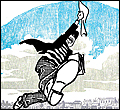
Superintendent Dr. Terri Holden gave the annual "State of the Schools" address at an Oct. 30 meeting. (Video still)
District talks state report card
- Published: November 14, 2025
Yellow Springs Schools presented its annual “State of the Schools” report Wednesday, Oct. 30, with Superintendent Terri Holden offering an overview of district demographics, academic performance and ongoing work to strengthen readiness in literacy and postsecondary pathways.
Holden opened by reminding those present that the State of the Schools presentation is “when we get to tell our story,” adding that “if we don’t tell our story, someone will tell the story for us.”
She reported that district enrollment this fall stands at 608 students, with about 36% of students qualifying for free and reduced lunch. Roughly 17% of district students are identified with disabilities.
This year’s presentation again featured the Ohio Schools Report Card, released in September. The district received an overall rating of 4.5 stars — the same rating it received last year — indicating performance that exceeds state standards. The rating reflects component scores of four stars in Achievement, five stars each in Progress, Gap Closing and Graduation, three stars in Early Literacy and one star in College, Career, Workforce and Military Readiness.
The district’s Achievement Index rose slightly to 86.6%, up from 85.8% last year. Progress scores were also strong; the district met or exceeded expected growth in nearly all tested areas across grades 4–8 and multiple high-school end-of-course subjects. Seventh grade English language arts and high school American government underperformed.
Math results stood out, including single-year gains in seventh grade math from 37.9% to 55% and algebra from 70% to 77%. Holden noted that the district had identified those areas for improvement last year, and credited new math curricula at both campuses, in part, for the improvement.
Graduation received five stars, consistent with previous years. Holden and board members praised growth in gap closing, which measures whether underserved student groups are performing on pace with their peers. Board President Rebecca Potter said the results “speak volumes to the dedication of our administration and our educational staff.”
Absenteeism rates decreased by 4.2% from last year, with 21.5% of students reported as chronically absent, or having missed more than 10% of school-year instruction. Despite improvement, Holden said absenteeism remains a point of concern. Holden noted declines in absentee rates across most student groups, but said: “We are the third worst in Greene County … we should not be the third worst.” She called it “an area for more improvement.”
The district’s overall rating dipped below a five-star composite this year because of the newly scored College, Career, Workforce and Military Readiness, or CCFMR, component. YS Middle and High School Principal Jack Hatert told the board this is the first year the category has carried star value, representing 13% of the district and 18% of the middle and high school report card. He noted that the criteria for CCFMR were finalized in February, with districts first receiving training in March — then graded using data from the class of 2024, before programming could be revised.
There are 11 criteria considered for the CCFMR rating; four Hatert said, are highly academic, such as reaching a remediation-free SAT/ACT score, earning an honors diploma, passing at least three AP exams or earning 12 College Credit Plus credits. A student may also qualify through military enlistment, but only if they took the ASVAB, or Armed Services Vocational Aptitude Battery, in high school.
“If you enlist in the military but never took the ASVAB, it does not count for the score,” he said.
Other criteria consider participation at Greene County Career Center, where comparatively few Yellow Springs students are enrolled. The model, Hatert said, overlooks a large cohort of students who do not fit the state’s prescribed pathways but are poised for successful postsecondary lives.
“A lot of students who go to college and are wildly successful did not have the remediation-free score on their ACT,” he said, adding that with many schools going test-optional, the ACT “is not actually a predictor of success in college.” He described the criteria as “somewhat missing for that middle group of students who still have all the tools to be wildly successful, but did not fit into one of these items or criteria from the state.”
Board member Dorothée Bouquet noted that the CCFMR criteria, in prioritizing remediation-free ACT/SAT test results, could be seen as “penalizing students who are in need of those accommodations.”
“It makes it really hard for a lot of students to accomplish that, yes,” Hatert said in reply.
He added that the district will not abandon academically rigorous coursework to chase a more favorable score.
“We don’t know that that’s necessarily in the best interest of our kids,” he said, noting that AP instruction often provides a deeper academic experience, even if it is harder to convert into CCFMR points than College Credit Plus credits. Holden said superintendents statewide have already raised concerns over the measure and believe that, if revised, “it’s going to be more workforce items … because that is where the Department of Education and Workforce is going.”
Still, Hatert said Yellow Springs is responding strategically. Last year’s rollout of the Individual Career and Academic Plan, experiential learning offerings and revised senior project expectations were intended to “be intentional about giving our kids what they need.” He said preliminary results suggest the district’s CCFMR score will rise to three stars next year.
The report card’s three-star rating in Early Literacy also drew attention. The score reflects that 77.8% of third-grade students demonstrated proficiency in reading. Holden described the rating as “not bad,” but an area in which “we’re going to get better.”
Assistant Superintendent Megan Winston explained that early literacy is measured through reading proficiency, promotion and the number of students entering and exiting Reading Improvement and Monitoring Plans.
“We knew it was room for improvement,” she said.
The district has expanded targeted supports, reinforced stamina practice for lengthy assessments and adopted a new writing curriculum.
“Teachers immediately could see how the rigor increased,” Winston said, pointing out that adding preschool classes to Mills Lawn in the future, as is the plan for the campus once it’s renovated, “will play a role in early literacy.”
Mills Lawn Principal Becca Huber described a new buildingwide structure around intervention blocks, enabling small-group instruction. Writing, she said, is a central focus as students transition from “learning to read to reading to learn.” Students practice both handwriting and typing; Huber said keyboarding has become essential, because “if you’re not comfortable typing, it really gets in the way of giving your thoughts.”
Holden closed her presentation by underscoring what she described as the district’s defining strengths: project-based learning, a growing STEM and coding pathway, robust arts opportunities, engineering partnerships and student-driven community engagement. Though the report card remains a benchmark, she said, it is only part of the story.
“Yellow Springs is just so unique, and that spirit shines through our students,” Holden said. “They’re confident, creative and unafraid to be themselves, and these are qualities that define our school culture.”
The State of the Schools address also included a financial update from Treasurer Jacob McGrath; that portion of the Oct. 30 meeting will be covered in next week’s issue of the News.
The Yellow Springs News encourages respectful discussion of this article.
You must login to post a comment.
Don't have a login? Register for a free YSNews.com account.















No comments yet for this article.